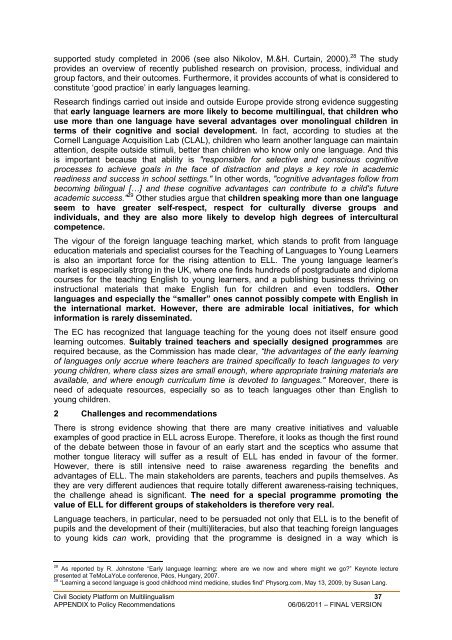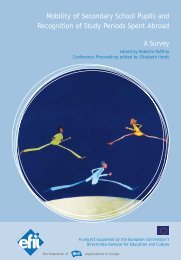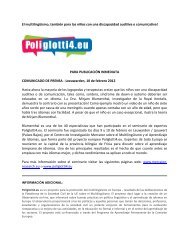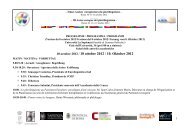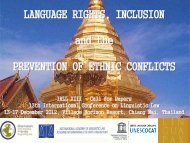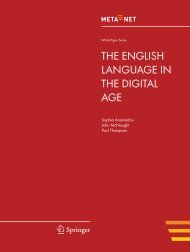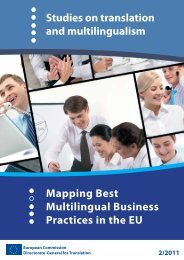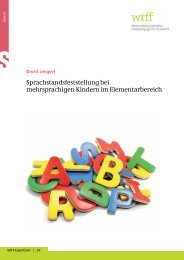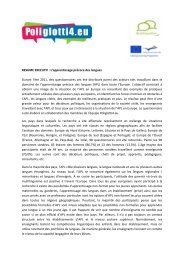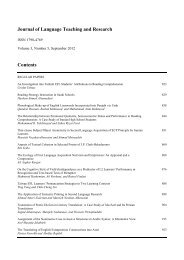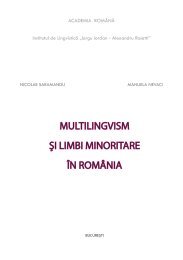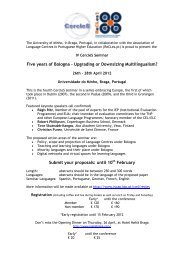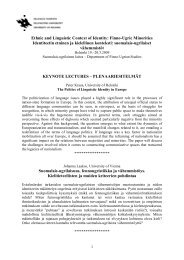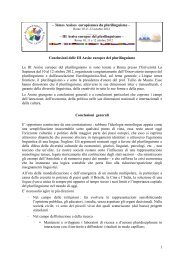FULL VERSION - European Commission - Europa
FULL VERSION - European Commission - Europa
FULL VERSION - European Commission - Europa
You also want an ePaper? Increase the reach of your titles
YUMPU automatically turns print PDFs into web optimized ePapers that Google loves.
supported study completed in 2006 (see also Nikolov, M.&H. Curtain, 2000). 28 The studyprovides an overview of recently published research on provision, process, individual andgroup factors, and their outcomes. Furthermore, it provides accounts of what is considered toconstitute ‘good practice’ in early languages learning.Research findings carried out inside and outside Europe provide strong evidence suggestingthat early language learners are more likely to become multilingual, that children whouse more than one language have several advantages over monolingual children interms of their cognitive and social development. In fact, according to studies at theCornell Language Acquisition Lab (CLAL), children who learn another language can maintainattention, despite outside stimuli, better than children who know only one language. And thisis important because that ability is "responsible for selective and conscious cognitiveprocesses to achieve goals in the face of distraction and plays a key role in academicreadiness and success in school settings." In other words, "cognitive advantages follow frombecoming bilingual […] and these cognitive advantages can contribute to a child's futureacademic success." 29 Other studies argue that children speaking more than one languageseem to have greater self-respect, respect for culturally diverse groups andindividuals, and they are also more likely to develop high degrees of interculturalcompetence.The vigour of the foreign language teaching market, which stands to profit from languageeducation materials and specialist courses for the Teaching of Languages to Young Learnersis also an important force for the rising attention to ELL. The young language learner’smarket is especially strong in the UK, where one finds hundreds of postgraduate and diplomacourses for the teaching English to young learners, and a publishing business thriving oninstructional materials that make English fun for children and even toddlers. Otherlanguages and especially the “smaller” ones cannot possibly compete with English inthe international market. However, there are admirable local initiatives, for whichinformation is rarely disseminated.The EC has recognized that language teaching for the young does not itself ensure goodlearning outcomes. Suitably trained teachers and specially designed programmes arerequired because, as the <strong>Commission</strong> has made clear, “the advantages of the early learningof languages only accrue where teachers are trained specifically to teach languages to veryyoung children, where class sizes are small enough, where appropriate training materials areavailable, and where enough curriculum time is devoted to languages." Moreover, there isneed of adequate resources, especially so as to teach languages other than English toyoung children.2 Challenges and recommendationsThere is strong evidence showing that there are many creative initiatives and valuableexamples of good practice in ELL across Europe. Therefore, it looks as though the first roundof the debate between those in favour of an early start and the sceptics who assume thatmother tongue literacy will suffer as a result of ELL has ended in favour of the former.However, there is still intensive need to raise awareness regarding the benefits andadvantages of ELL. The main stakeholders are parents, teachers and pupils themselves. Asthey are very different audiences that require totally different awareness-raising techniques,the challenge ahead is significant. The need for a special programme promoting thevalue of ELL for different groups of stakeholders is therefore very real.Language teachers, in particular, need to be persuaded not only that ELL is to the benefit ofpupils and the development of their (multi)literacies, but also that teaching foreign languagesto young kids can work, providing that the programme is designed in a way which is28As reported by R. Johnstone “Early language learning: where are we now and where might we go?” Keynote lecturepresented at TeMoLaYoLe conference, Pécs, Hungary, 2007.29“Learning a second language is good childhood mind medicine, studies find” Physorg.com, May 13, 2009, by Susan Lang.Civil Society Platform on Multilingualism 37APPENDIX to Policy Recommendations06/06/2011 – FINAL <strong>VERSION</strong>


